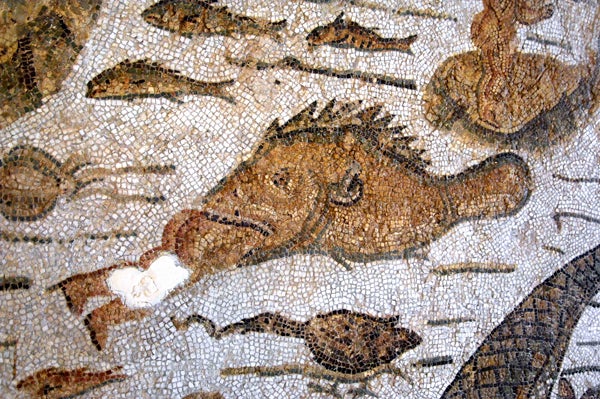|
September 7, 2011
Stanford researcher turns to Roman art for marine conservation
According to Hopkins Marine Station's Fiorenza Micheli, ancient mosaics of groupers can tell us that the endangered fish used to be bigger. By Max McClure

A detail of a mosaic from the Bardo National Museum in Tunis suggests that groupers were once much larger than they are now. (Photo: E. Trainito) The dusky grouper has been a popular target for Mediterranean fishermen since prehistoric times – their bones have been found in human settlements dating back more than 100,000 years. It's a slow growing, flavorful and, with the advent of modern sport fishing, endangered species.
In an effort to reverse the decline of multiple species, including groupers, a number of no-take marine reserves have been established across the Mediterranean. But it's proven difficult to evaluate the success of these protected areas precisely because humans have had an impact on the species for so long. Ideally, reserve biologists would compare modern fish to groupers hundreds or thousands of years ago, before the advent of large-scale commercial fishing.
"When we consider a species recovered, they may still in fact be altered relative to their original baseline," explained Fiorenza Micheli, a professor of marine ecology at Stanford's Hopkins Marine Station.
Now, in an effort to look farther back into the grouper's history than traditional ecological methods allow, Micheli and Paolo Guidetti of the University of Salento in Italy have looked to art history. Using depictions of the fish in Roman mosaics, the researchers suggest that groupers should be much larger and should be found at shallower depths than they are today. The paper appears this week in Frontiers in Ecology and the Environment.
Fishing scenes were not uncommon sources of inspiration for coastal Mediterranean artists. Micheli and Guidetti found hundreds of Etruscan, Greek and Roman artworks involving sea creatures. Fish depicted in mosaics were often detailed enough to be recognizable as dusky groupers.
But unlike today's animals, the groupers in Roman mosaics are depicted as being enormous – in one case, large enough to eat a fisherman whole.
Though the researchers pointed out that this example could be a case of artistic license, the depictions imply that groupers were large enough to be considered "sea monsters." By comparison, groupers in unprotected waters today range from 50-60 centimeters (20-24 inches) in length.
Even more surprising, mosaics show men fishing for groupers with harpoons at the water's surface. Today, this would be unheard of – modern sport fishermen spearfish groupers in deep water. But writings from the time corroborate this Roman view of the grouper as a shallow-water fish – the Roman writers Pliny and Ovid both describe angling for groupers from shore.
"It's particularly interesting that there are children fishing from the boats," said Micheli in reference to the Louvre's "Triumph of Neptune and Amphitrite," which depicts cupids harpooning a grouper. "One interpretation would be that it's so easy to fish them that kids could do it."
The good news is that grouper populations in no-take reserves show signs of returning to these historical numbers and sizes. Reserve biologists report that populations that haven't seen fishing for years do begin to move into shallower waters. Groupers in protected areas achieve population abundances five to 10 times greater than those in the rest of the Mediterranean, and can reach sizes of 90-100 centimeters.
Unfortunately, these advances mainly highlight the failed recovery of dusky groupers at large. Because the average size of many grouper populations is smaller than the size of sexual maturity, current conditions appear unsustainable.
"One extreme suggestion would be to place a moratorium on grouper fishing, because they're not recovering outside of a few small marine reserves," said Micheli. "But this would be an unpopular measure." Sport fishing is a major tourism draw in the Mediterranean, and one of the primary targets is grouper.
But ignoring historical, qualitative sources of ecological data, Micheli pointed out, creates the risk of producing a drastically distorted view of baseline conditions.
"At the moment, we're missing a major player in Mediterranean shallow-water ecosystems," she said.
Max McClure is an intern at the Stanford News Service.
-30-
|